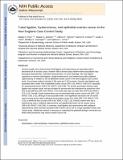| dc.contributor.author | Rice, Megan Siobhan | |
| dc.contributor.author | Murphy, Megan | |
| dc.contributor.author | Vitonis, Allison F. | |
| dc.contributor.author | Cramer, Daniel William | |
| dc.contributor.author | Titus, Linda J. | |
| dc.contributor.author | Tworoger, Shelley Slate | |
| dc.contributor.author | Terry, Kathryn Lynne | |
| dc.date.accessioned | 2016-04-20T17:54:43Z | |
| dc.date.issued | 2013 | |
| dc.identifier.citation | Rice, Megan S., Megan A. Murphy, Allison F. Vitonis, Daniel W. Cramer, Linda J. Titus, Shelley S. Tworoger, and Kathryn L. Terry. 2013. “Tubal Ligation, Hysterectomy and Epithelial Ovarian Cancer in the New England Case-Control Study.” Int. J. Cancer 133 (10) (July 9): 2415–2421. doi:10.1002/ijc.28249. | en_US |
| dc.identifier.issn | 0020-7136 | en_US |
| dc.identifier.uri | http://nrs.harvard.edu/urn-3:HUL.InstRepos:26639506 | |
| dc.description.abstract | Previous studies have observed that tubal ligation and hysterectomy are associated with a decreased risk of ovarian cancer; however little is known about whether these associations vary bysurgical characteristics, individual characteristics, or tumor histology. We used logistic regression to examine tubal ligation, simple hysterectomy, and hysterectomy with unilateral oophorectomy in relation to risk of epithelial ovarian cancer in the New England Case-Control study. Our primary analysis included 2,265 cases and 2,333 controls. Overall, tubal ligation was associated with a lower risk of epithelial ovarian cancer (OR: 0.82, 95%CI: 0.68-0.97), especially for endometrioid tumors (OR=0.45, 95%CI: 0.29-0.69). The inverse association between tubal ligation and ovarian cancer risk was stronger for women who had undergone the procedure at the time of last delivery (OR=0.60, 95%CI: 0.42-0.84) rather than at a later time (OR=0.93, 95%CI: 0.75-1.15). Overall, simple hysterectomy was not associated with ovarian cancer risk (OR: 1.09, 95%CI: 0.83, 1.42), although it was associated with a non-significant decreased risk of ovarian cancer among women who underwent the procedure at age 45 or older (RR: 0.64, 95%CI: 0.40, 1.02) or within the last 10 years (OR=0.65, 95%CI: 0.38, 1.13). Overall, women who had a hysterectomy with a unilateral oophorectomy had significantly lower risk of ovarian cancer (OR=0.65, 95%CI: 0.45-0.94). In summary, tubal ligation and hysterectomy with unilateral oophorectomy were inversely associated with ovarian cancer risk in a large population-based case-control study. Additional research is necessary to understand the potential biologic mechanisms by which these procedures may reduce ovarian cancer risk. | en_US |
| dc.language.iso | en_US | en_US |
| dc.publisher | Wiley-Blackwell | en_US |
| dc.relation.isversionof | doi:10.1002/ijc.28249 | en_US |
| dc.relation.hasversion | http://www.ncbi.nlm.nih.gov/pmc/articles/PMC3772657/ | en_US |
| dash.license | OAP | |
| dc.subject | tubal ligation | en_US |
| dc.subject | tubal sterilization | en_US |
| dc.subject | hysterectomy | en_US |
| dc.subject | epithelial ovarian cancer | en_US |
| dc.title | Tubal ligation, hysterectomy and epithelial ovarian cancer in the New England Case-Control Study | en_US |
| dc.type | Journal Article | en_US |
| dc.description.version | Accepted Manuscript | en_US |
| dc.relation.journal | International Journal of Cancer | en_US |
| dash.depositing.author | Cramer, Daniel William | |
| dc.date.available | 2016-04-20T17:54:43Z | |
| dc.identifier.doi | 10.1002/ijc.28249 | * |
| dash.contributor.affiliated | Murphy, Megan Alicia | |
| dash.contributor.affiliated | Rice, Megan | |
| dash.contributor.affiliated | Tworoger, Shelley | |
| dash.contributor.affiliated | Cramer, Daniel | |
| dash.contributor.affiliated | Terry, Kathryn | |


